If we have to define a museum, it is an institution dedicated to collecting, preserving, interpreting, and displaying objects of artistic, cultural, historical, or scientific significance. These objects may vary in dates and culture and provide raw and pure material to read and research about anything in particular.
India, with its rich history and culture, is home to many museums. However, the creativity and collections of some of these museums are the most exquisite! Come and have a look!
1. National Museum, Delhi

Established in 1949, the museum has objects varying from archeology, jewelry, paintings, arms and armor, ancient manuscripts, decorative arts, etc. A total of 2,00,000 works of exquisite art, both Indian and foreign, some of it dating back to almost 5000 years, makes it one of India’s biggest repositories of knowledge! A depiction of our rich cultural heritage, the museum is now a house to some of the greatest archeological excavations, including the ‘Dancing Girl,’ ‘Pashupati Seal’ from the Indus Valley civilization, the ‘Surya’ statue from the Sun temple Konark, and others.
2. Indian Museum, Kolkata
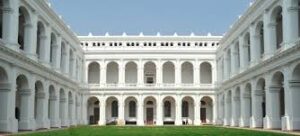
Founded in 1814 under the Asiatic Society of Bengal, the Indian Museum in Kolkata is Asia’s biggest and oldest operating multipurpose museum! It serves as a large home to preserves of decorative arts, insects, mammals, bronze, coins, rocks and minerals, paintings, botany, invertebrate fossils, and many more. The white building, with a collection of 35 galleries, evokes the British era while offering a deep insight into the histories of its preserves. The most exquisite part of the museum is the Egyptian section, which has a preserved mummy!
3. Chhatrapati Shivaji Maharaj Vastu Sangrahalaya, Mumbai

The foundation stone of this museum was laid on 11 November 1905 by the Prince of Wales. The museum’s building is truly an art of the Indo-Saracenic style; the Indian pillars, the huge domes, and a well laid-out garden make the museum look absolutely breathtaking! It has some of the most exquisite collections from different sections, including art, scriptures, sculptures, arms and armour, jewellery, textiles, etc., from across the world.
4. National Rail Museum, Delhi
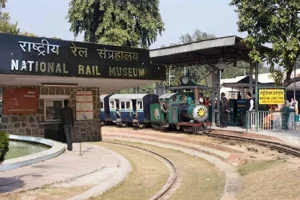
Founded on 7th October 1971, it was set up as the first-ever transport museum in India under the name ‘Rail Transport Museum.’ Spread over a land of 11 acres, the museum does not fail to capture the essence of the journey of Indian railways from its dawn of it. The extensive outdoor gallery holds a variety of steam, diesel, and electric transports, along with a collection of fancy royal salons, parlors, carriages, and wagons. These life-size models give us a clear insight into the past and early lives of the mode of transportation. Make sure to have a look around to catch glimpses of historical photographs, documents, railway artifacts, etc.
5. Heritage Transport Museum, Gurgaon

Situated in the Tauru of Gurgaon district, the Heritage Transport Museum is one of the most prominent museums in India. A great source to the history of human transportation, the museum houses a huge collection of vintage and classic cars, bicycles, and another mode of transportation. The outlook of the museum will give you the absolute vintage vibe with the most classic vehicles you have ever laid your eyes upon! You will also spot some of the most interesting facts about air and army transportation as well! A collection of about 75 exhibits with over 100 vehicles will definitely leave you awe-struck!
6. Salar Jung Museum, Hyderabad
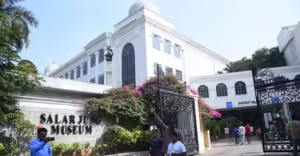
Established in 1951, the museum is considered as an ‘Institution of National Importance.’ The collection was under the care of Salar Jung III, but due to no direct heirs, the government took it under itself (1958). The collection was moved to the residence of Salar Jung III, which is now the museum. The vast and beautiful collection of the museum is spread across three distinct buildings and is divided into 38 galleries. The museum houses a famous marble sculpture ‘Veiled Rebecca’ crafted by the famous Italian neoclassical sculptor, Giovanni Maria Benzoni. The sculpture is breathtakingly beautiful and the creases carved out on the marble make it look so real!
7. The Sulabh International Toilet Museum, Delhi
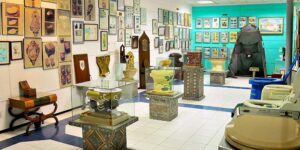
This unique kind of museum was an initiative to educate the public about the history of toilets. The museum houses pictures, facts, documents, and artifacts ranging from the time of the evolution of toilets in 2500 BC to the present time. The facts present here are about different topics, including the evolution of toilets, the breaking of social norms/taboos related to toilets, and even toilet etiquette! The museum is run by Sulabh International and is dedicated to the global history of sanitation and toilets.
8. Folklore Museum, Mysore
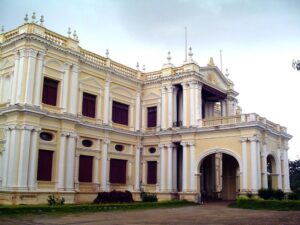
The museum was established in 1968 and is located at the University of Mysore. It is famous for its vast collection of arts and crafts from all over Karnataka (nearly 6,500 indigenous-made artifacts). The building, which was once a mansion (the Jayalakshmi Vilas Mansion), now has its halls filled with artifacts, paintings, and other ancient objects. One of its halls is dedicated to the writers and poets, displaying their clothes, pens, watches, diaries, etc. A different section of the museum is dedicated to the folk performing arts such as Yakshagana and Kathakali. Gigantic puppets also coexist with their smaller counterparts crafted from leather and wood, alongside straw dolls.
9. Losel Doll Museum, Dharamshala
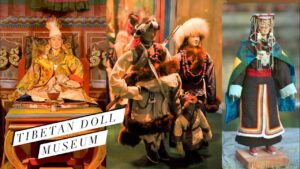
A unique museum nestled in the lap of Dharamshala, Himachal Pradesh, it is dedicated to the preservation and display of the Losel dolls, which are traditional Tibetan dolls. All the dolls here in the preserve are handmade and hand-designed and depict the different peoples of Tibetan society. The collection includes dolls of nomads, farmers, kings, royals, and monks. Different festivals and celebrations are also depicted through these dolls. The accuracy of accessories, clothing, surroundings, and even facial expressions make these dolls rather more attractive to visitors!
10. Kite Museum, Paldi
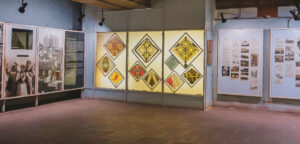
It is the first-ever kite museum in India and houses more than 100 unique kites made with different materials. Mr. Bhanu Shah, a fond collector of kites, donated his collection to the Ahmedabad Municipal Corporation in 1984. Special thematic kites with miniature paintings and festival-based kites are all part of this exhibition. The famous hexagonal Japanese Kite called Rokoku can also be spotted here. The museum also shows the history of kites and their contribution to some of the greatest inventions of the world.
11. Mayong Central Museum, Mayong
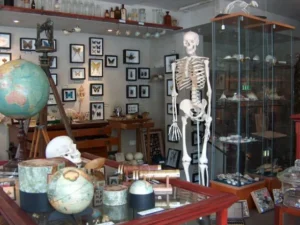
The Mayong village, hidden deep in the Morigaon district of Assam, is famously known for witchcraft and black magic being practiced here. The Mayong Central Museum in the Mayong village is a rich preserve of the artifacts used in black magic, different weapons, and ancient manuscripts. Whether you are a believer or a non-believer, this museum is a must-visit for you to have a look into this different dimension of the world. the museum houses an exquisite collection of old coins, manuscripts, jewelry, and bracelets made up of skulls and bones, which were used to perform the rituals or were worn by those who performed these rituals.
12. VECHAAR Museum, Ahmedabad
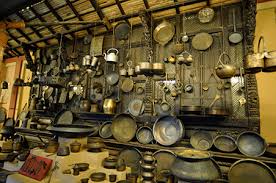
Clink, clink! This museum will take you on a round through bronze, copper, zinc, steel, iron, mud, and even German silver utensils! This iconic collection of utensils features collections from different states like Orissa, Madhya Pradesh, Tamil Nadu, etc. The VECHAAR stands for Vishala Environmental Centre for Heritage of Art, Architecture and Research. The museum is home to almost 4,500 unique utensils and other metal items like betel leaf boxes, Hukka, dowry boxes, nutcrackers, etc.
13. Delhi Metro Museum, Delhi

Well yes, it’s obvious from the title that this museum is a luxurious collection of metro and its related information. However, did you know that the museum is located inside a metro station itself? Well yes, the Delhi Metro Museum is located inside the Patel Chowk metro station and is South Asia’s first-ever metro museum! The museum traces the dawn and evolution of the Delhi metro. There are books available about the construction of the metro, which attracts many young engineers and researchers. There are interactive pods with audio and videos that demonstrate different technical aspects of the metro.
Watch out this blog::15 Stunning Tourist Attractions in India to Add to Your Bucket List
CONCLUSION
Museums play a crucial role in society both by safeguarding cultural, historical, and scientific artifacts and providing them to society as a medium to read and research about these particulars. The purpose of museums could be defined as a preserve of the past to educate the present for a better future, and these glorious museums of India do not fail to fulfill these purposes.

